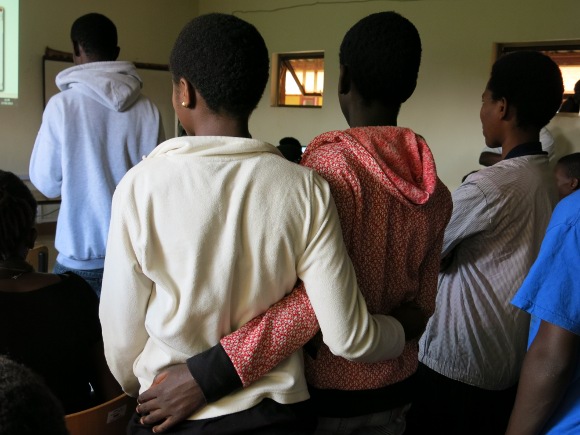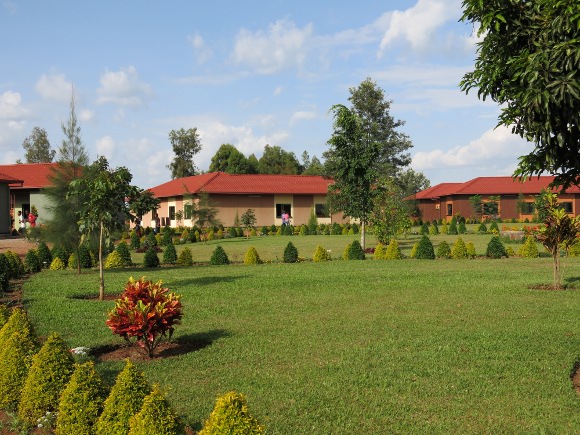
A week ago, I began the process of moving from my graduate program at The Fletcher School of Law and Diplomacy in Boston to Kigali, Rwanda, for summer graduate work. I had the good fortune of meeting Anne Heyman, the founder of the Agahozo-Shalom Youth Village, a community village and high school for orphans of the genocide in Rwanda. When many of us think of an “orphanage,” we often think of an overcrowded, run-down place. ASYV proves this stereotype wrong. On my second day in Rwanda, JC, the director of the Village, called me to ask if I was free the next day to visit the Village for the students’ science expo. I quickly agreed, and on my third day in Rwanda I travelled with the ASYV staff from Kigali to the Village. After about an hour of driving, we stopped on a beautiful road that overlooked the hills of Rwanda, with a view of a lake in the distance. JC told me this was the beginning of the Village’s land, which was fairly purchased from over 50 land owners.
When I arrived in the Village, students were milling about, making last-minute preparations to their science projects and presentations. The day began with near 500 students standing together and listening intently as the directors of the Village officially opened Science Day 2013. The students then gathered in the first two rooms, where technology and computer presentations were made. Students presented, and teachers asked questions that challenged the students to think critically and apply their projects to the real world.
There were projects on the effects of drinking soda on the liver, of acids and bases in food, of reproduction of human life, and demonstrations of how telephone and sound waves work. Each presentation was clear, and all of the students seemed proud of their work. Students were hugging each other, congratulating one another, and were listening intently to their classmates’ presentations.

JC called one of the boys to join us at our table, whose photo I had seen in the Times article. He introduced himself, and I was immediately struck by his respect, self-confidence yet humility, and his ability to think big. We spoke about dedicating our lives to helping others. He told me about his visit with the Holocaust survivor in New York, and how surprised he was by the similarities of their experiences.
He especially was surprised by how the Nazis called the Jews names, which he said happened in his own country. He was struck by how this older generation is focused on making the world a better place, and working to ensure that the hate they experienced is not repeated. The student hopes that his “small abilities” can contribute in some way. He wants to study economics to solve problems in the world.
I can tell you that the abilities of the students at the ASYV are not small. Having been a teacher, working with students and young people for many years, I can say the abilities of these children are immense. They enjoy a nurturing community, complete with family time, village time, and a secure home. Empowerment, family, and respect are a way of life in the Village, the norm, not the exception.
The Rwandan genocide left a young population in the country, and investment in youth education and programs cannot be ignored in order to create a sustainable Rwandan future. The student who joined me for lunch reminded me of the power of youth, that young people’s ideas should be fostered and their education taken seriously, whether they are wealthy, poor, black, white, born into privilege, or survivors of genocide.
When I returned to Kigali, I told a colleague about my visit to Agahozo-Shalom, which opened in 2008, and she said it would have been great if this village existed in 1997. The country really needed something like this. The reputation the village has gained since then is justified, as it holistically responds to a major problem of orphans in Rwanda. The question remains, is it too late?
I believe we have not missed the opportunity on youth education. Rwanda and many of its neighbouring countries need villages like the ASYV. Investing in youth education has immense returns. As Marc Sommers describes in his new book Stuck, the youth bulge in Rwanda remains a major issue.
Walking around the Youth Village, I can see the pride the students take in learning. This shows that fostering opportunities for youth to learn the skills to enter the work force or university and obtain positions in leading companies, NGOs, and government organizations, is essential to ensure positive prospects for the future of developing countries. Young people are the future of Rwanda, and youth villages like the ASYV are teaching future leaders to dream and to become engaged global citizens.
We all have the choice to give and to receive, and at different points in our life we do one, the other, or both. The students at the ASYV have learned how to manage a life of true giving and true receiving, and will benefit from both the sorrows and joys they experience. Their resilience will continue to inspire.










